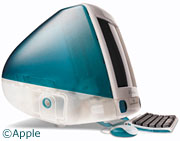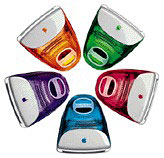Q. How can I upgrade my G3 iMac?
A. The iMac was and remains one of Apple’s best selling computers. Now in its umpteenth revision, sporting LCD screens and faster than ever processors, the iMac has come quite a long way from the original 233 MHz Bondi blue bombshell. While many people lust for the new snow-colored iMac, many people are still left with a slightly fruitier variant of this computer on his or her desk.
 However, this is no reason to be discouraged. While there’s no feasible way to get the older iMacs to have the new styling and other features of the current iMac, there are still plenty of ways to get the pep back into these not-so-useless older iMacs.
However, this is no reason to be discouraged. While there’s no feasible way to get the older iMacs to have the new styling and other features of the current iMac, there are still plenty of ways to get the pep back into these not-so-useless older iMacs.
Today, we’ll talk about some of the options you have to supercharge your iMac.
Processor Upgrades
Speed is probably the major concern when it comes to upgrading an older 233 MHz or 266 MHz iMac – or even a faster one. The easiest way to speed up an iMac is through a processor upgrade. Sonnet and PowerLogix make upgrade cards for these computers, and Newer Tech used to (theirs are usually available through TechnoWarehouse). Chris Lawson’s Upgrading an iMac article from 2000 provides an early look at these power-boosters.
Some of these upgrade cards have features like FireWire ports (which aren’t available on the 350 MHz iMacs and below) or G4 processors, which can further your upgrade experience. See our Guide to iMac CPU Upgrades for more details on current and discontinued iMac processor upgrades.
Memory
The original iMac came with only 32 MB of RAM. This can be a problem for anyone wanting to run anything above Mac OS 8.1. With enough memory, the iMac can handle Mac OS X 10.2 – and probably later versions when they come out. Upgrading the memory well beyond 32 MB should be a primary concern for most users.
The memory in the original 233-333 MHz iMacs (the ones with a tray for the CD, not a slot) can be pricier and more confusing than the RAM in other Macs from this era, such as the Blue and White G3. These iMacs use SO-DIMM memory, the same type found in PowerBook G3s. It can be found on eBay relatively cheap. However, RAM upgrades are limited on the Rev A-D iMacs because they can only support up to 256 MB of RAM.
 Editor’s note: Users have reported mixed results upgrading memory in the Rev. A, Rev. B, Rev. C (266 MHz), and Rev. D (333 MHz) iMacs. Some manage to get two 256 MB modules working; others can’t get their computer to recognize anything larger than 128 MB. We have two seemingly identical Rev. Ds at Low End Mac headquarters – one takes a 256 MB upgrade, but the other won’t. Same computer. Same firmware revision. Same brand of memory. We have not been able to determine why there is so little consistency among tray-loading iMacs. dk
Editor’s note: Users have reported mixed results upgrading memory in the Rev. A, Rev. B, Rev. C (266 MHz), and Rev. D (333 MHz) iMacs. Some manage to get two 256 MB modules working; others can’t get their computer to recognize anything larger than 128 MB. We have two seemingly identical Rev. Ds at Low End Mac headquarters – one takes a 256 MB upgrade, but the other won’t. Same computer. Same firmware revision. Same brand of memory. We have not been able to determine why there is so little consistency among tray-loading iMacs. dk
The later revisions, 350 MHz and up, use the more common PC100 RAM, which can be more readily found – and at lower prices. They all support much higher amounts of RAM, up to one gigabyte. Depending on how you’ll use your newly improved iMac, 256 MB will probably be fine. However, memory is probably the cheapest way to speed up your older iMac.
For current prices on SO-DIMM and PC100 memory to upgrade your iMac, check out the latest deals listed at Other World Computing. As we go to press [Early 2003], 128 MB SO-DIMMs go for as little as US$19, 256 MB for $44 and up, 128 MB PC100 as low as $19, 256 MB from $31, and 512 MB starts at $60.
Hard Drives
The iMac’s 4 GB hard drive was thought to be huge when it first rolled out. However, with huge office programs and 1000+ song MP3 collections, a larger hard drive will probably be necessary. For most people, the 40 GB hard drive found in today’s 600 MHz iMac will probably be sufficient. But for people with the smaller hard drives found in earlier iMacs, upgrading to a larger hard drive might be an appropriate option.
The older iMacs use the common IDE hard drive interface, so finding a compatible hard drive shouldn’t be a problem, and when you do find one, it shouldn’t be too expensive either. You’ll probably make your iMac faster at the same time, since today’s hard drives tend to be faster than the ones Apple put in these iMacs.
If you have a Rev. A-D iMac, add a hard drive bigger than 8 GB, and there’s any possibility at all that you’ll run OS X on it at some point, be sure to partition the drive with a first partition no larger than 8 GB. This is the only way you’ll be able to boot OS X on these older iMacs.
Software
The last major upgrade that can improve your overall computer experience is software. While some of the upgrades won’t necessarily make your computer faster, the enhanced features of OS X will allow you to run newer software and will really allow you to exploit the features of your other upgrades.
Conclusion
While there are more things you can do to upgrade your computer, such as VRAM upgrades (only on the earliest iMacs) and overclocking the CPU (see iMac ClockUp for an article that covers Rev. A-D iMacs – and proceed at your own risk), the ones we’ve talked about today are probably going to give you the most bang for your buck. The whole purpose of being low-end and upgrading is really defeated when you spend more on upgrades than you would on a new computer.
Short link: http://goo.gl/LEkHpG
searchword: imacg3upgrade

